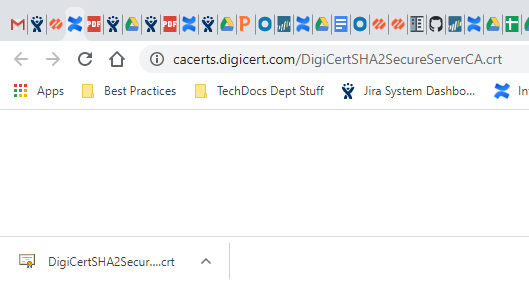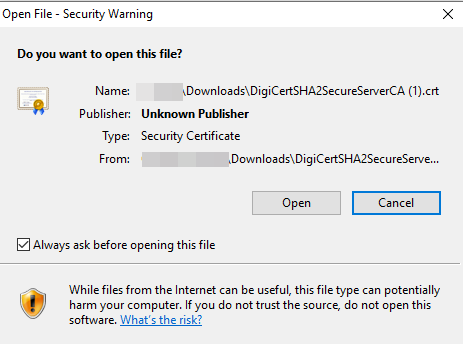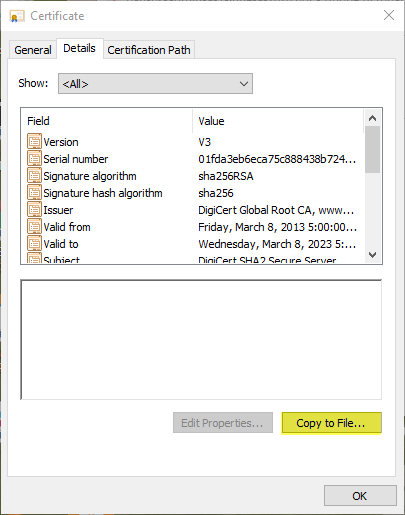Repair Incomplete Certificate Chains
Table of Contents
End-of-Life (EoL)
Repair Incomplete Certificate Chains
Locate and install missing intermediate certificates
to fix incomplete certificate chains using the Decryption log.
Not all websites send their complete certificate
chain even though the RFC 5246 TLSv1.2 standard requires authenticated servers to provide a valid
certificate chain leading to an acceptable certificate authority (CA). When you
enable decryption and apply a Forward Proxy Decryption profile that
blocks sessions with untrusted issuers to a Decryption
policy rule, if an intermediate certificate is missing from the certificate list the
website’s server presents to the firewall, the firewall can’t construct the
certificate chain to the top (root) certificate. In these cases, the firewall
presents its Forward Untrust certificate to the client because trust can't be
established without the missing intermediate certificate.
The firewall also presents its Forward Untrust certificate
if traffic matches a Decryption profile that allows sessions with untrusted
issuers.
The firewall only has root certificates
in its Default Trusted Certificate Authorities store.
If a website you need to communicate with for business purposes has one or more missing
intermediate certificates and the Decryption profile blocks sessions with untrusted
issuers, then you can find and download the missing intermediate certificate and
install it on the firewall as a trusted root CA so that the firewall trusts the
site’s server. (The alternative is to contact the website owner and ask them to
configure their server so that it sends the intermediate certificate during the
handshake.)
If you allow sessions with untrusted issuers in the Decryption profile, the firewall can
establish sessions even if the issuer is untrusted. The firewall presents the
Forward Untrust certificate to the client and displays a warning message in the
browser, which enables users to accept the risk and continue to the site or not.
However, it's a best practice to block sessions with untrusted issuers for
better security.
- Find websites that cause incomplete certificate chain errors.
- Filter the Decryption log to identify Decryption sessions that failed because of an incomplete certificate chain.In the filter field, type the query (err_index eq Certificate) and (error contains ‘http’). This query filters the logs for Certificate errors that contain the string “http”, which finds all of the error entries that contain the CA Issuer URL (often called the URI). The CA Issuer URL is the Authority Information Access (AIA) information for the CA Issuer.Click an Error column entry that begins “Received fatal alert UnknownCA from client. CA Issuer URL:” followed by the URI.
![]() The firewall automatically adds the selected error to the query and shows the full URI path (the full URI path may be truncated in the Error column).Copy and paste the URI into your browser and then press Enter to download the missing intermediate certificate.
The firewall automatically adds the selected error to the query and shows the full URI path (the full URI path may be truncated in the Error column).Copy and paste the URI into your browser and then press Enter to download the missing intermediate certificate.![]() Click the certificate to open the dialog box.
Click the certificate to open the dialog box.![]() Click Open to open the certificate file.
Click Open to open the certificate file.![]() Select the Details tab and then click Copy to File....
Select the Details tab and then click Copy to File....![]() Follow the export directions. The certificate copies to the folder you designated as your default download folder.Import the certificate into the firewall.
Follow the export directions. The certificate copies to the folder you designated as your default download folder.Import the certificate into the firewall.- Navigate to DeviceCertificate ManagementCertificates and then select Import.Browse to the folder where you stored the missing intermediate certificate and select it. Leave the File Format as Base64 Encoded Certificate (PEM).
![]() Name the certificate, specify any other options you want to use, and then click OK.When the certificate has imported, select the certificate from the Device Certificates list to open the Certificate Information dialog.Select Trusted Root CA to mark the certificate as a trusted root CA, and then click OK.
Name the certificate, specify any other options you want to use, and then click OK.When the certificate has imported, select the certificate from the Device Certificates list to open the Certificate Information dialog.Select Trusted Root CA to mark the certificate as a trusted root CA, and then click OK.![]() In DeviceCertificate ManagementCertificatesDevice Certificates, the imported certificate now appears in the list of certificates. Check the Usage column to confirm that the status is Trusted Root CA Certificate.Commit the configuration.You have now repaired the broken certificate chain.The firewall doesn’t block the traffic because the CA issuer is now trusted. Repeat this process for all missing intermediate certificates to repair their certificate chains.
In DeviceCertificate ManagementCertificatesDevice Certificates, the imported certificate now appears in the list of certificates. Check the Usage column to confirm that the status is Trusted Root CA Certificate.Commit the configuration.You have now repaired the broken certificate chain.The firewall doesn’t block the traffic because the CA issuer is now trusted. Repeat this process for all missing intermediate certificates to repair their certificate chains.







